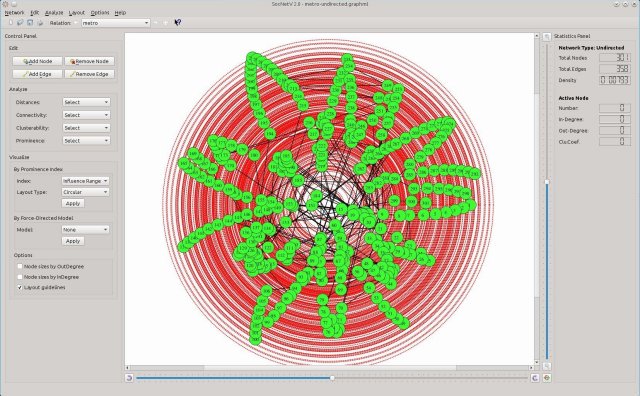Social Network Visualizer (SocNetV) has recently released version 3.2, enhancing its capabilities as a powerful social network analysis and visualization tool. This application allows users to construct social networks (both graphs and directed graphs) from scratch or import existing networks in various formats such as GraphML, UCINET, and Pajek.
The updated features of SocNetV include advanced metrics for assessing network properties, including cohesion, centrality, community detection, and structural equivalence. Users can apply multiple layout algorithms that leverage actor centrality or prestige scores, such as Eigenvector and Betweenness centrality, as well as dynamic models like spring-embedder algorithms for better visualization.
Key functionalities of SocNetV encompass:
- Automatic creation of well-known network datasets and random network models, including scale-free networks, Erdős–Rényi models, Watts-Strogatz small worlds, and d-regular networks.
- Comprehensive support for various social network formats, including GraphML, adjacency lists, and two-mode affiliation networks.
- Rapid computation of centrality indices (Degree, Closeness, Betweenness, etc.) and prestige metrics, facilitating in-depth analysis.
- Unique network layouts based on centrality and prestige indices, including radial layouts and PageRank analysis.
- Capability to crawl websites to generate networks, conduct a triad and clique census, and utilize structural equivalence methods like hierarchical cluster analysis and actor similarity.
- Efficient export options in GraphML, Pajek, and adjacency formats, alongside an online manual and technical documentation for user assistance.
- The application is optimized for handling large networks with over 1,000 actors and 10,000 edges while maintaining low memory and CPU usage.
Overall, SocNetV 3.2 represents a significant advancement in social network analysis, making it a versatile tool for researchers and analysts in the field. Its robust feature set positions it as a valuable asset for exploring complex social structures and relationships.
In future updates, it would be beneficial to see enhancements in user interface design for better accessibility, the integration of machine learning algorithms for predictive analysis, and more extensive community support for troubleshooting and sharing insights among users
The updated features of SocNetV include advanced metrics for assessing network properties, including cohesion, centrality, community detection, and structural equivalence. Users can apply multiple layout algorithms that leverage actor centrality or prestige scores, such as Eigenvector and Betweenness centrality, as well as dynamic models like spring-embedder algorithms for better visualization.
Key functionalities of SocNetV encompass:
- Automatic creation of well-known network datasets and random network models, including scale-free networks, Erdős–Rényi models, Watts-Strogatz small worlds, and d-regular networks.
- Comprehensive support for various social network formats, including GraphML, adjacency lists, and two-mode affiliation networks.
- Rapid computation of centrality indices (Degree, Closeness, Betweenness, etc.) and prestige metrics, facilitating in-depth analysis.
- Unique network layouts based on centrality and prestige indices, including radial layouts and PageRank analysis.
- Capability to crawl websites to generate networks, conduct a triad and clique census, and utilize structural equivalence methods like hierarchical cluster analysis and actor similarity.
- Efficient export options in GraphML, Pajek, and adjacency formats, alongside an online manual and technical documentation for user assistance.
- The application is optimized for handling large networks with over 1,000 actors and 10,000 edges while maintaining low memory and CPU usage.
Overall, SocNetV 3.2 represents a significant advancement in social network analysis, making it a versatile tool for researchers and analysts in the field. Its robust feature set positions it as a valuable asset for exploring complex social structures and relationships.
In future updates, it would be beneficial to see enhancements in user interface design for better accessibility, the integration of machine learning algorithms for predictive analysis, and more extensive community support for troubleshooting and sharing insights among users
Social Network Visualizer 3.2 released
Social Network Visualizer (SocNetV) is a social network analysis and visualization application.


